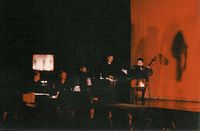 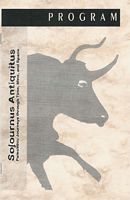 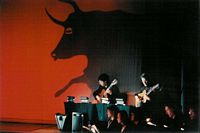 在上古的时间是独特的戏剧演出多媒体节目生产在Schoolcraft学院在1996年5月17-19的利福尼亚密执安城市。 它是姐妹项目对 "化石的冲击"。 摄影: Shekinah Errington (左照片: 阶段的左边在中国样式阴影面纱前面的: 二个电子键盘,非洲鼓和大提琴,与计算机和电视屏幕。 射出在阴影面纱上从后面: "的8位演员和舞蹈家; Shamanic Dance." 右边照片: 阶段的右边在阴影面纱前面的: 6歌手SATB唱诗班[女高音、女低音、男高音和低音],古典和钢串吉他和曼陀林。 射出在从后部的阴影面纱上: 著名Lascaux公牛石洞壁画阴影模板在"的法国; Purity"黎明; 序列)。 节目盖子: Schoolcraft学院计算机图表技术部。 |
关于原物的有些事实1996年在上古时间的生产
-
3 years in the making
-
Made possible by a grant from Schoolcraft College, Livonia, Michigan
-
Involved over 50 faculty, staff, and students from most of the larger universities and colleges in Southeast Michigan and neighboring Canada (institutions represented included Schoolcraft College; University of Michigan; Cranbrook Institute of Science; University of Windsor, Canada; Central Michigan University; Eastern Michigan University; Wayne State University; and Greenhills School of Ann Arbor)
-
Involved many local musicians, dancers, artists, and technicians
-
Involved the Michigan Flintknappers and flintknappers from Cranbrook Institute of Science (as well as primitive artifacts on loan from Cranbrook for the Sojournus Antiquitus Pre-Show Gallery).
-
Largest theatrical live-performance multimedia program ever produced at the College
-
The College devoted an entire semester of its Computer Graphics Technology classes to the project
-
Also involved Music, Media, and Computer Information Technology Departments
-
All three performances were sold out in the intimate 170-seat theater May 17, 18, & 19, 1996.
-
Sojournus Antiquitus was in the runnings for a larger production at the 1997 Ann Arbor Summer Festival but lost out to a safer-bet return performance by Ray Charles.
- 这页只开始了。 有来的更多 - |
Feliks, J. 1998. The Making of Sojournus Antiquitus: A Multidisciplinary Union of Anthropology and the Arts. Presented by Professor Judith Calleja (Central Michigan University) at the Central States Anthropological Society 75th Anniversary Meeting (American Anthropological Association), April 2-5, 1998. Kansas City, Missouri.
作者的有些出版物
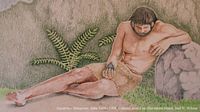 The "natural representations theory" as it appeared front-projected in the "North Star" sequence of Sojournus Antiquitus and as Figure 1 in The Impact of Fossils ("North Star" sequence colored pencil on illustration board drawings by Joel N. Wilson. Impact of Fossils version by John Feliks with assistance from Shekinah Errington and Gerry Hermann).
The "natural representations theory" as it appeared front-projected in the "North Star" sequence of Sojournus Antiquitus and as Figure 1 in The Impact of Fossils ("North Star" sequence colored pencil on illustration board drawings by Joel N. Wilson. Impact of Fossils version by John Feliks with assistance from Shekinah Errington and Gerry Hermann).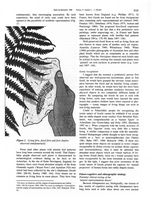
Feliks, J. 1998. The impact of fossils on the development of visual representation. Rock Art Research 15: 109-34.
Feliks, J. 2006. Musings on
the Palaeolithic fan motif. In P. Chenna Reddy (ed.), Exploring the mind of ancient man: Festschrift to Robert G. Bednarik, 249-66. Research India
Press, New Delhi.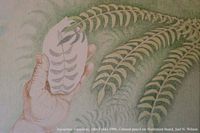
Feliks, J. 2008. Phi in the Acheulian: Lower Palaeolithic intuition and the natural origins of analogy. In Bednarik, R. G. and D. Hodgson (eds), Pleistocene palaeoart of the world, pp. 11-31. Proceedings of the XV UISPP World Congress (Lisbon, 4-9 September 2006), BAR International Series 1804, Oxford.*
Feliks, J. 2009 (in press). The graphics of Bilzingsleben: Sophistication and subtlety in the mind of Homo erectus. Proceedings of the XV UISPP World Congress (Lisbon, 4-9 September 2006), BAR International Series, Oxford.*
Feliks, J. 2009. A Lot of Gold in the Mix: Review of Fragment from a Nonfiction Reader. Pre-publication review of the debut science thriller by Warren Fahy (see quotation on the author's review page under FRAGMENT: Reviews).
Feliks, J. 2009. The idea of protolanguage considered in the context of archaeological evidence. Comment on "From protolanguage to true language," by Blair Bolles. Babel's Dawn [Internet]. Available at: http://www.babelsdawn.com/babels_dawn/2009/04/from-protolanguage-to-true-language.html.
Feliks, J. 2009. The handaxe shape in microliths. Comment on "Is a hand ax really a hand ax," by Michael Balter. Origins: a history of beginnings [Internet]. Available at: http://blogs.sciencemag.org/origins/2009/02/is-a-handax-really-a-handax.html.
*(BAR is British Archaeological Reports.)
关于作者和网站前提